Writing counter-geography
Capsized boats and clandestine migrants washing up on European shores: these are the dramatic images by which the European Southern border gets into the news again and again. The media seems to say that these images communicate the essence of the border in its most compressed and climactic form. But there is no defining image of drama that can narrate the endless story of inclusion and exclusion. There can be no violent icon to which the event of crossing can be reduced to, only the plurality of passages, their diverse embodiments, their motivations and articulations. Turning the focus away from the simple trespassing of a line towards exposing the transnational, diffuse and semi-legal economic transactions behind the multiple movements within the borderlands might bring us closer to understanding the site and how perfectly the clandestine boat passages fit into the whole picture. At the same time it places the event in the framework of a narrative that can transcend media representations, particularly the news format. Theory and video can be an effective alliance in redefining the documentary. In this instance, we can speak of the convergence of a theoretical analysis of globalization, the ethnographies of the material reality of women in areas of crisis, the abstraction of technological representations as well as the critique of their function as hegemonic visualizations.
These are the diverse modes and parameters pertinent to the reading of the work I’m going to discuss.
My artistic and curatorial work pursues an ongoing interest in the transformation of space due to the movement of people in an effort to understand how human trajectories, their migration paths and travel routes, have formed particular cultural and social landscapes and how these experienced patterns finally inscribe themselves into the physical terrain. When it comes to the visualization of these processes, studies of geography and migration are increasingly aided by advanced image technologies so that the representation of geographic movements has to be investigated both in the material and electronic terrain.
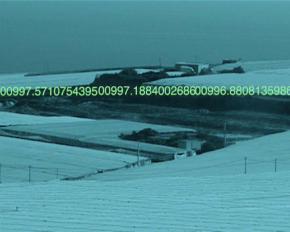 Writing counter-geographies
Writing counter-geographies
At the center of the following reflections lies the question of how I could insert myself, as an artist, into these image making processes and engage in writing a kind of counter-geography in which the electronic and social landscapes overlap. In this context, geography is thought of as a theoretical instrument that allows us to reconsider the space-subject-movement relations and also as a cultural practice, as a symbolic way of redesigning space. The crucial question is what kind of visual worlds are being created in the process, what impact these images target or what promise they resist fulfilling.
Europlex, made in collaboration with visual anthropologist Angela Sanders, is a video which looks at the Spanish Moroccan borderlands. What we can call the border there is not a linear formation. It encompasses the Strait of Gibraltar with all its transversal traffic, the two Spanish Enclaves on the Moroccan side and the plastic covered vegetable plantations in Andalusia powered by an African labor force. When we see geography as a spatialization of the relationships connecting systems ranging from the local to the transnational, it also becomes plain why, in border geographies, there are processes of extreme compression on all levels. The funneling functions of actual border stations intended to regulate the flow of people are only the visible points of convergence for connecting strands that are spread over a region or link up continents. At these bottlenecks, the hindrances of a mobile world have to get by without embellishing words. Until recently, Málaga and Almería did not see themselves as borders; nowadays, the whole of Spain’s southern coastline has to uphold the country’s European identity, however this is formulated. The simplest form is still, as ever, exclusion.
Europe defines itself by its outermost edge.
The two Spanish enclaves of Ceuta and Melilla, situated on Moroccan territory, form an exception to the line of the border, which otherwise faithfully follows the coastlines of the two continents. They are wefts in an already complex fabric, last remnants of the colonial occupation of North Africa. With the heavy financial grants that the EU gives to the disadvantaged southern regions of Europe, the Spanish administration there is building fortresses in the form of shopping precincts and elegant beach arcades as signs of Europe’s wealth, and also as a way of setting the enclaves apart
from the neighboring Moroccan towns. Borders take on a number of architectural forms.
The video concentrates on the differing ways in which the specific area of the Strait of Gibraltar and the regions bordering on it are used, as well as on the varied need for mobility. This area is given its cultural meaning only by being crossed: by the routes of container ships from West Africa on their way to the Mediterranean, the perilous nocturnal boat voyages undertaken by clandestine migrants, the helicopter patrols keeping watch, by the lines of the radar pictures, the itinerant plantation workers who pick vegetables for the EU market, the commuting housemaids, the ”domesticas,” who go to work for the señoras in Andalusia, the seasonal movement of the Spanish teachers in the enclaves, the patrols of the border guards along the mountain paths, the bus trips of the Moroccan women who peel imported shrimps for Dutch companies in Tangier, the pirates who buy articles imported from China in Spain, and the women smugglers who tie them up under their skirts and carry them into the ”medina.”This is the mobility that we are concerned with, the everyday mobility lived out on a local level. It produces micro-geographies that are deeply intermeshed with one another and at the same time reflect global dimensions.
Our video Europlex and the derived installation Estrecho complex (Détroit complex) exhibited in Le Quartier, examine, in a series of border recordings, the circular movement of people around the checkpoint between the Spanish Enclave Ceuta and the surrounding Moroccan territory. This checkpoint controls the coastal road that ends at the most northern point in Ceuta. Directly across the Strait is Gibraltar and the Spanish mainland.At this extreme geographic location the flourishing city Ceuta has always been assigned the role of a well guarded bridgehead. The Moroccan harbor Tangier located on the Atlantic side of the Strait, due to its history marked by various European maneuvers, is considered a more cosmopolitan city with great plans for becoming a transnational trading place.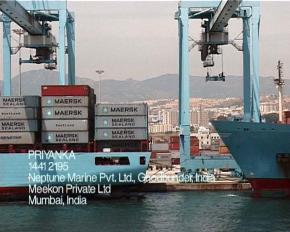
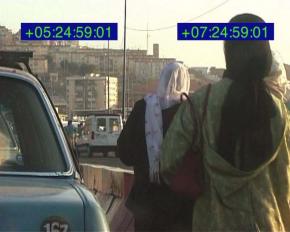
Logging the border
The videographic recordings which we call ”border logs”, relate to the two distinct sites Ceuta (border log I + II) and Tangier (border log III).We use the term ”log” to link the travel logs and the ethnographic recordings with the practice of video editing, whereby the log, i.e. the chronological list of the filmed material, is considered an indispensable preparation for the montage. Europlex, particularly in the first border journal, visualizes the observation process by describing just what it does, namely accurately registering the spatial-temporal process. It introduces a time, which allows an unhurried interpretation of the event, a temporal mode beyond the spectacular. Video becomes a cognitive tool. While this pragmatic procedure could be experienced elsewhere as utterly boring, it is almost a prerequisite for grasping the diffuse bustling in this location. At first sight it is rather difficult to make sense of the exhilarating confusing course of affairs occurring here and it requires more than one visit to the border to understand the logic of the busy multidirectional stream of people carrying a multitude of plastic bags and parcels.
“Border log I” is first of all a meticulous observation of the extensive smuggling activities that circumscribe the frontera de tarajal, the border to Ceuta. Filming is strictly prohibited so that images can be made only under constant interruptions, with a hidden camera or from a distance. The liveliness begins at 6 am when the gates open to the crowd of impatiently waiting Moroccans and continues through the day. Smuggling takes place in the daylight in front of the eyes of the officials and is part of the everyday culture. Many of the smugglers come from the town Tétuan nearby, others from villages of the Rif mountains further away. The aim of the border crossing is not to get into the city of Ceuta but to pursue their semi-legal business in the expanded border complex. Wholesale warehouses and street markets are just around the corner from the checkpoint. Here they rummage around for good deals and buy as much as they can carry. Some articles such as wool blankets are better quality and still cheaper than in Morocco, even though they are not necessary made in Spain but imported from China. Still, they will be marketable in Tétuan. On their way back, the smugglers pass, this time heavily loaded, in front of the same officials who get compensated for their forebearance. Circumscribing the architecture of the authorities up to eleven times a day, they inhabit the border in a non-linear, circular way, carving out an existence for themselves. Towards the best possible mobility for crossing, the female smugglers strap shirts and cloths to their body, layer by layer, until they have doubled their body volume. This seems to be a technique only women use. Every piece will increase the profit margin of her passage. The economic logic inscribes itself onto every layer of the transforming, mobile, female body.
“Border Log II” follows the daily journey of the Moroccan maids who live in the Moroccan town Tétuan and work in the enclave. Since Spanish women increasingly seek paid work outside her home, the need for cheap domestic personal in the enclave city has grown. Most of the service personal gets recruited from the neighboring Moroccan region, only very few will be given a work contract which would guarantee minimum salary and facilitate easier entrance into the enclave.
So for many the day begins by being shoved through the crowded gated passage on the border, hoping to be let in. The state officials use every pretext to slow down or congest the flow completely.
Yet Europlex doesn’t focus on the difficult conditions young Moroccan women are facing when they enter the European labor market. It rather takes a look at the casual but unusual detail that the workers commute between the Moroccan and the European time zones. Due to the fact that the two adjacent territories are located in distinct time zones with a two hour time lapse, the domestic workers turn into permanent time travelers within the border economy. Her life rhythm is off beat, it is performed through an alternating delay and acceleration with respect to her social context. Deferred time becomes the mode of their cultural positionality. In the video, the time travelling maid is repre sented in front of an electronically generated, organically moving pop striped background, her gesture and her smile appear unnaturally repetitive, they are interrupted by drop-outs, i.e. missing images
which stop and restart in a choppy fashion. The animated portrait of the Muslim woman takes on likeable robotic features that withdraw her from our time measurement.
“Border log III” enters the transnational zone near Tangier where Moroccan women manufacture biological and technological products for European subcontractors. As in so many other places on the edge of advanced states, we recognize here the typical mechanism of globalization i.e. the outsourcing of labor intensive processes under more advantageous conditions regarding wage, labor rights and taxes. Tangier wants to position itself as the most important transnational trade center in the Southern Mediterranean basin at the beginning of the 21st century. As I have argued elsewhere with regards to the U.S. Mexican border, transnational zones are comparable to heterotopian places which distinguish themselves by not being embedded in the cultural context but operating according to another, remote controlled set of rules and rationals. Like in Mexico, in Tangier too there is mainly a female work force being taken into consideration for jobs in the disfranchized zone. The border crossed by these women on a daily basis is a lot less visible than the fortified one around Ceuta passed by the smugglers and domestic workers. Still, upon entering the transnational zone the worker experiences a distinctive split from her cultural environment. In Europlex this fissure comes to expression in a series of female workers portraits captured at the exit of a factory in the harbor of Tangier. In terms of image technology it is performed by means of a brusque freeze of her image, her face and her gaze remain sharp while the background dissolves gradually into graininess beyond recognition.
Accompanied by electronic rhythms the sequence is overlaid by fast accumulating figures suggesting labor hours and performance statistics. In this fragmented composition her presence is decontextualized, her body entirely technologized.
These log journals describe three diverse practices which transform the border space into a translocal reality.What the border recordings aim at and attempt to impact on is not the consolidation of a national unity but on the contrary the permeability and constant subversion of it. Television reports on clandestine boat passengers do that too, to some extent, but it seems crucial to me that the shadowy and partially subversive circumstances of these border passages are not assimilated all too quickly into a disciplined national order, where intervening state officials play the leading part, but that they are allowed to cultivate an alternative imaginary based in translocal existences and transformative cultural practices.
The freestanding radar video in the installation version Estrecho Complex has been captured in the control tower of Algeciras, the second largest container harbor in the Mediterranean. The tower oversees all navigation activities across the Strait. Visual contact with the vessels is provided by surveillance cameras located in the harbor areas and through radar signals rendered on monitors whereas vocal contact is established via radio with the captains. In the video, these two separate media of communication are brought together. The clean technological representation of radar lines which trace the projected path of each ship through the waters of Gibraltar is juxtaposed with the crackling radio announcements of heavily accented captains from all over the world, occasionally interrupted by snatches of Moroccan music blasting from one of the ship cabins. These are the rough disruptive embodied voices that introduce cultural meaning to the organizing electronic maps.
Southern Spain and Northern Morocco form a space that may be powered and ruled by the European economy but that is ultimately produced by the people who are moving across and in between the territorial imperative of the borders. The focus is not on the global players, not on the deconstruction of power, but consists in the accurate observation of counter-geographies and dissident practices, mostly semi-legal, often invisible. It could be significant, then, to produce knowledge and visual intelligence about the course and meaning of these border circuits, to understand how they repeat themselves discursively and semiotically and how the transborder passengers described in the border logs imprint and give meaning to this performative space.We are not speaking about any old urban formation but border constructs, enclaves and free trade zones, places which are not embedded in the surroundings but artificially created alian zones, which belong to a different operative logic and are therefore translocal. A sensitive, strategically wanted economic drop typcially characterizes the outer boundaries of the translocal zone, which invariably entails an accelerated traffic of humans and goods. While there are clearly postcolonial and transnational motivations standing behind these emplacements, the
local inhabitants usually don’t take long to recognize the possibilities of setting up alternative economic circuits that will profit the whole region.The problem arises from the fact that these improvised transnational activities withdraw from legal regulations which are designed to address primarily the needs of the trade relations of corporations. That’s how micro-economies drift too easily into semi-legal fields of actions where the goodwill of officials, feudal work conditions and piracy make the rules.
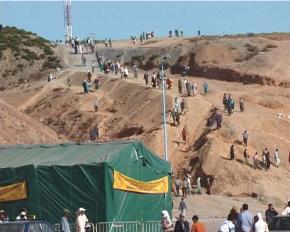
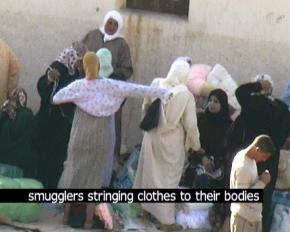
Generating symbolic spaces for agency
All of my videos explicitly deal with topics that are not art immanent. They experiment, nevertheless, with aesthetic and theoretical forms assigned to the essay rather than the documentary genre.
Essayist practice is highly self-reflexive in that it constantly reconsiders the act of image-making and the desire to produce meaning. It is consciously engaged in the activity of representation itself. These characteristics make the genre particularly suited to study complex relations. The essayist approach not about documenting realities but about organizing complexities. This ability is very valuable since video has to respond not only to a changing media environment but also to an increasingly complex society, where the mere depiction of visible realities has become insufficient. The essay is good at capturing the more abstract, intangible processes of social and cultural transitions. This quality makes the essay particularly suitable for my investigations about globalisation processes. There are a number of parallels that can be drawn between the material and the metaphorical reading of the term “transnational.”
Not unlike transnationalism, the essay practices dislocation, it sets across national boundaries and continents and ties together disparate places through a particular logic. In the essay, it is the voice over narration that ties the pieces together in a string of reflections that follow a subjective logic. The narration in the essay, the authorial voice, is clearly situated in that it acknowledges a very personal view, a female migrant position, a white workers position, - and this distinguishes it from a documentarian voice or a scientific voice. The narration is situated in terms of identification but it isn’t located in a geographic sense. It’s the translocal voice of a mobile, traveling subject that doesn’t belong to the place it describes but knows enough about it to unravel its layers of meaning. Alone to gather information and facts is hardly of interest, for the essay doesn’t believe in the representability of truth, the essayist intention lies much rather in the reflection about the world and the social order. and it does that by arranging the material into a particular field of connections. In other words, the essayist approach is not about documenting realities but about organizing complexities. It has always distinguished itself by a non-linear and non-logical movement of thought that draws on many different sources of knowledge.
Since my work is based on the assumption that geographic space is ultimately constituted through the various movements of people, it could also be interesting to look at the role of the body in the transnational zone as well as in the essayist space. In the documentary tradition, reality is attached to a body, the camera focuses on the experiencing body, the social actor, in that sense it is a historical body. In fiction, on the other hand, the body represents a narrated figure, it is a narrated body. But in the
essay, the bodies are not instrumentalized in either way, they do not have to perform representative functions. On the contrary, in their self-reflexive way, the essayist bodies contribute to constructing other things. In this event, they construct borders.
My videos are equally shown and discussed in activist, academic and art contexts. It is certainly desirable that the videos enter and impact the diverse spaces since they are themselves a synthesis of data originating from all these various areas of knowledge production. In the heat of the discussions in the public and educational realm it is striking to observe how quickly activist and artistic aims are mixed up and confused. The indirect question of what a video is capable of achieving emerges at almost every presentation regardless of the context. This might be due to the fact that the treatment of a subject matter which triggers a sense of social injustice, however distanced and structural it is being represented in the video, demands for solutions which I do not supply. This attitude is possibly grounded in the common practice used in journalist reports and documentaries whereby a social problematic is made palpable through the description of a singular fate, making the individual suffering more perceivable. I find theprocedure of stimulating concern quite suspect since the effect is an emotional, often voyeristic kick which politically speaking doesn’t lead anywhere, not towards agency in any case. Nevertheless, maybe precisely because it doesn’t come to application in the video, the creating-concern-formula shines through in the expectation of the audience. The frustration changes into the attitude that the video wasn’t capable of changing unacceptable living conditions and therefore somehow insufficient. If the video would be shown in places, so the questions from the audience, where things needed to be changed.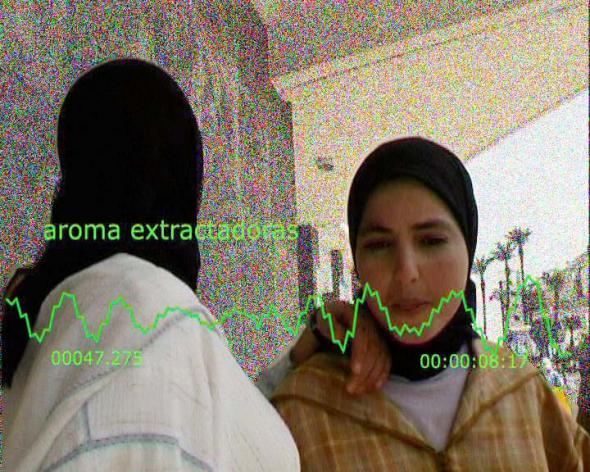
Of course there is a myriad of well organized and globally networked NGOs who are particularly well placed to achieve change on social and legislative levels. But this is decisively not the site of my intervention. My aesthetic practice is aimed at generating different kinds of spaces of agency, even if it happens often enough that NGOs use my videos for lobby and public relations purposes. I have decided to act in the symbolic realm. The aim is not to change the world out there but the discourse about the world out there. However, the questions from the audience often mark the decisive moment when I’m assured that the project achieves what it intends, namely to sharpen the consciousness about ones proper accountability for global developments. In my artistic and textual work, I try to elaborate, wherever possible, on the correlation between high-technologized societies and the production of precarious living conditions. One of my prime concerns is the willingness to recognize that causes and solutions are not always located somewhere on the “outside”.
*See “The Transnational Video”, em: Ursula Biemann (éd.), Stuff It - the video essay in the digital age,
Voldemeer/Springer,Vienne et New York, 2003.
Europlex, Ursula Biemann & Angela Sanders, 20 min., 2003
published in:Appel à témoin, Le Quartier, Centre pour l’art contemporain, Quimper, 2003